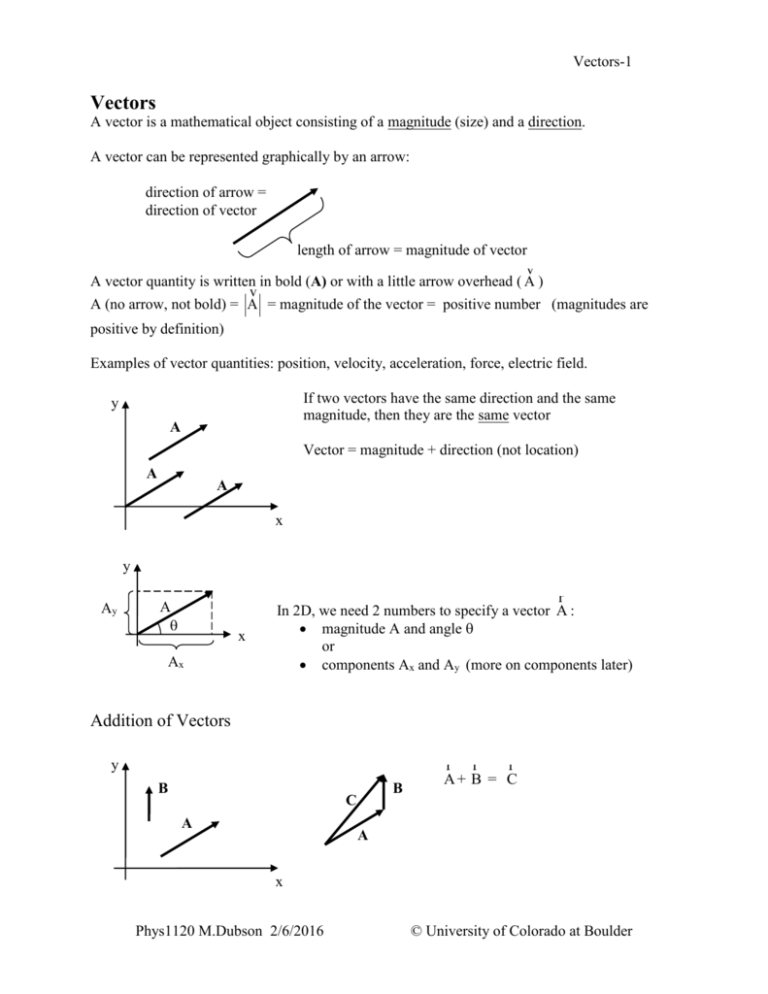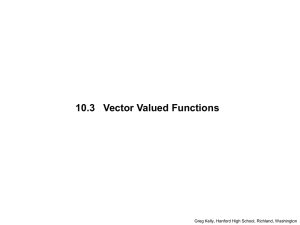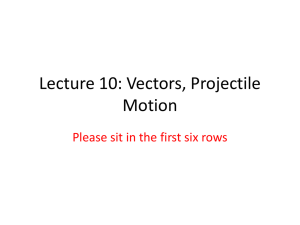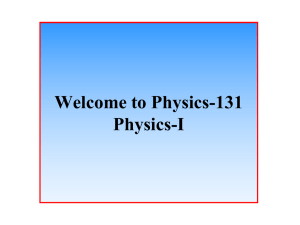Vectors - University of Colorado Boulder
advertisement

Vectors-1 Vectors A vector is a mathematical object consisting of a magnitude (size) and a direction. A vector can be represented graphically by an arrow: direction of arrow = direction of vector length of arrow = magnitude of vector v A vector quantity is written in bold (A) or with a little arrow overhead ( A ) v A (no arrow, not bold) = A = magnitude of the vector = positive number (magnitudes are positive by definition) Examples of vector quantities: position, velocity, acceleration, force, electric field. If two vectors have the same direction and the same magnitude, then they are the same vector y A Vector = magnitude + direction (not location) A A x y Ay A x Ax r In 2D, we need 2 numbers to specify a vector A : magnitude A and angle or components Ax and Ay (more on components later) Addition of Vectors y B B C A r r r A+ B = C A x Phys1120 M.Dubson 2/6/2016 © University of Colorado at Boulder Vectors-2 r r r r Vector addition is commutative: A + B = B + A Graphical addition: "tip-to-tail" or "tail-to-head" method: A B C C B A Addition by "parallelogram method" (same result as tip-to-tail method) C B A Can add lots of vectors (like steps in a treasure map: "take 20 steps east, then 15 steps northwest, then…") r r r r r r A+ B + C+ D+ E = S D E C B S A Definition of negative of vector (same size, opposite direction): A A Definition of multiplication of a vector by a number: b =3 A c = 2 bA 3 times as long as A B cB negative c flips direction What about multiplication of a vector by a vector? There are two different ways to define multiplication of two vectors: (1) Dot product or scalar product A B and (2) Cross product A B These will be defined later. Phys1120 M.Dubson 2/6/2016 © University of Colorado at Boulder Vectors-3 Vector subtraction: v v v v A - B = A + (- B) "substract" means "add negative of" v v v Graphically: D = A - B B D B B A B A D A v v v D = A- B A D B v v v is the same as D + B = A is same as v v v B+ D = A Components of a Vector v A = A x xˆ + A y yˆ y ( x̂ = "x-hat" is the unit vector, explained below) A Ay x Ax Ax = A cos = x-component = "projection of A onto x-axis" Ay = A sin = y-component = "projection of A onto y-axis" Think of the Ax as the "shadow" or "projection" of the vector A cast onto the x-axis by a distant light source directly "overhead" in the direction of +y. Components are numbers, not vectors. They do not have a direction, but they do have a sign, a (+) or (–) sign. If the "shadow" onto the x-axis points in the +x direction, then Ax is positive. light rays y A x Ax y Here, Bx is negative, because the x-projection is along the x direction. By is positive, because the y-projection is along the +y direction. B By Bx x Phys1120 M.Dubson 2/6/2016 © University of Colorado at Boulder Vectors-4 Ax Þ A x = A cos q A Ay sin q = Þ A y = A sin q A cos q = A Ay Ax A = Ax 2 + Ay2 tan q = Ay Ax r Magnitude A = | A | is positive always, but Ax and Ay can be + or . Unit Vectors A unit vector is a vector with magnitude = 1 (unity). Notation: a unit vector is always written ˆ y, ˆ and zˆ , also written ˆi , ˆj, and kˆ , are the unit vectors with a caret (^) on top. The unit vectors x, that point along the positive x-direction, y-direction and z-direction, respectively. Any vector can be written in terms of its components like so: y v A = A x ˆi + A y ˆj ˆj x î For instance, if Ax = 2 , Ay = –3, then the vector looks like : y A x ˆi A y ˆj v A x v Example of vector math: A = 2 ˆi - 3 ˆj , meaning Ax = +2, Ay = 3 What is the magnitude A, and the angle of the vector with the positive x-direction? y x A = Ax 2 + Ay2 = A 3 tan a = 3 2 Þ 22 + 32 = 4+ 9 = 13 ; 3.6 æ3 ö a = tan - 1 çç ÷ = 56.3o ÷ çè 2 ÷ ø 2 Phys1120 M.Dubson 2/6/2016 © University of Colorado at Boulder Vectors-5 Vector Addition by Components: v v v C = A+ B Þ C x = A x + Bx Proof by diagram: y C y = A y + By C B A x Bx Ax Cx Similarly, subtraction by components: v v v D = A- B Þ D x = A x - Bx D y = A y - By Position, Velocity, and Acceleration Vectors Velocity is a vector quantity; it has a magnitude, called the speed, and a direction, which is the direction of motion. Position is also a vector quantity. Huh? What do we mean by the magnitude and direction of position? How can position have a direction? In order to specify the position of something, we must give its location in some coordinate system, that is, its location relative to some origin. We define the position vector r as the vector which stretches from the origin of our coordinate system to the location of the object. The x- and ycomponents of the position vector are simply the x and y coordinates of the position. Notice that that the position vector depends on the coordinate system that we have chosen. y ry =y location of object (x , y) r rx = x If the object is moving, the position vector is a function of time r = r(t). Consider the position vector at two different times t1 and t2, separated by a short time interval t = t2 – t1. (t is read "delta-t") The position vector is initially r1, and a short time later it is r2. The change in position during the interval t is the vector r = r2 – r1. Notice that, although r1 and r2 depend Phys1120 M.Dubson 2/6/2016 © University of Colorado at Boulder x Vectors-6 on the choice of the origin, the change in position r = r2 – r1 is independent of choice of origin. Also, notice that change in something = final something – initial something. v Dr lim . D t® 0 D t As t gets smaller and smaller, r2 is getting closer and closer to r1, and r is becoming tangent to the path of the object. Note that the velocity v is in the same direction as the infinitesimal r , since the vector v is a positive number (1/t) times the vector r. Therefore, the velocity vector, like the infinitesimal r, is always tangent to the trajectory of the object. v In 2D or 3D, we define the velocity vector as v = y path of object y r1 x v y r r r2 v r r2 r2 r r v r1 r x x v Dr lim has x- and y-components. The component equations are D t® 0 D t v v v Dx Dy v x = lim , v y = lim . Any vector equation, like A = B + C , is short-hand D t® 0 D t D t® 0 D t notation for 2 or 3 component equations: A x = Bx + Cx , A y = By + C y , Az = Bz + Cz v The vector equation v = The change in velocity between two times t1 and t2 is v = v2 – v1 (remember that change is v Dv v always final minus initial). We define the acceleration vector as a = lim . As we D t® 0 D t mentioned in the chapter on 1D motion, the direction of the acceleration is the same as the direction of v. The direction of the acceleration is NOT the direction of the velocity, it is the “direction towards which the velocity is tending”, that is, the direction of v. We will get more experience thinking about the velocity and acceleration vectors in the next few chapters. Phys1120 M.Dubson 2/6/2016 © University of Colorado at Boulder








